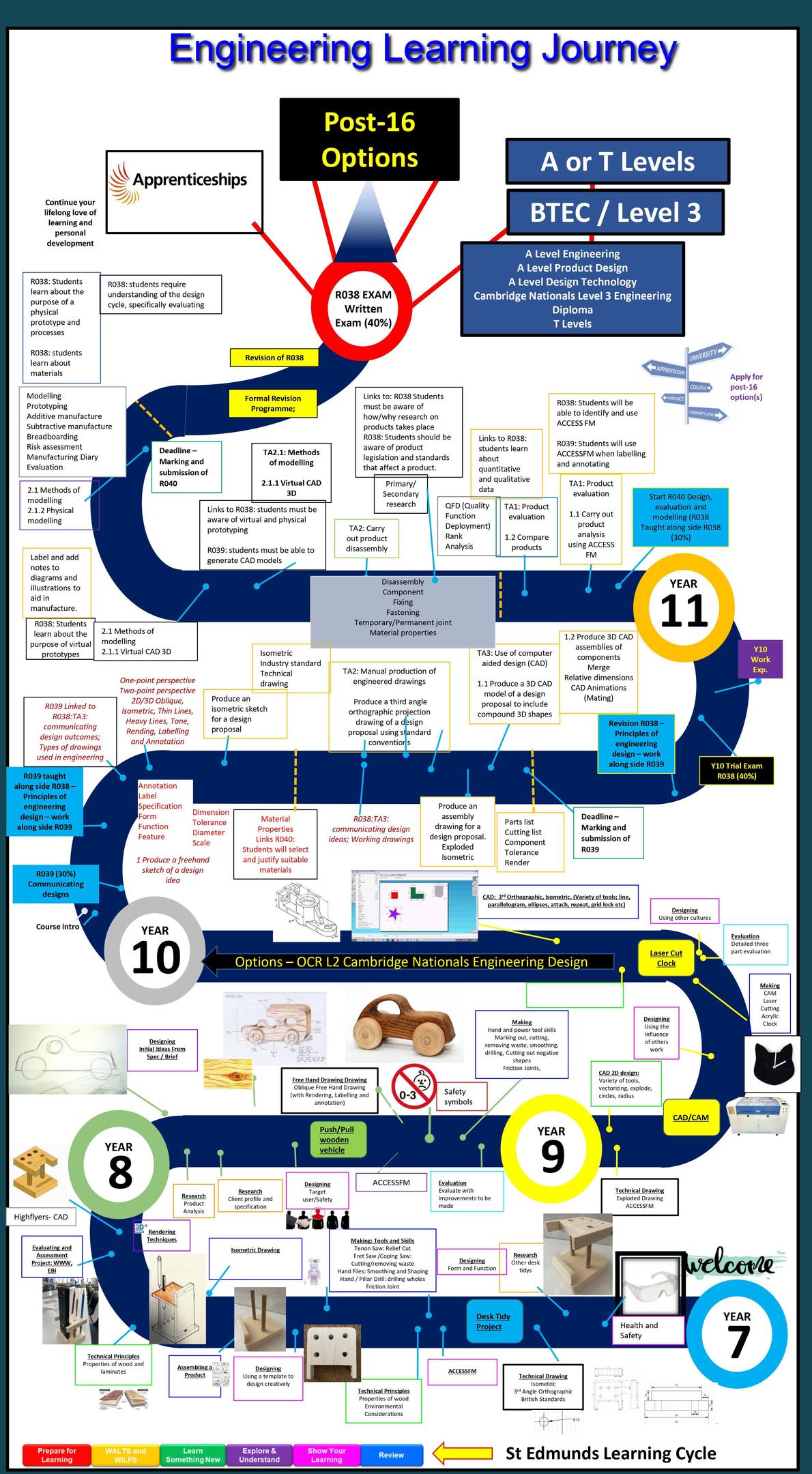Engineering
Intent
To create:
In Engineering at St Edmunds, our aim is that learners will develop their curiosity, inquisitiveness, critical-thinking and problem-solving skills, so that they can progress successfully through the key stages, onto further and higher education and then into a successful Engineering career. Students will learn transferable skills that will equip them for their future, everyday lives. We have developed an Engineering curriculum which gives opportunities to all pupils to create a culture of high aspirations; raises standards of personal and academic achievement and allows all young lives to achieve success, regardless of their starting point.
Implementation
Clear lines of progression through key stage 3 ensures good progression. Our focus is Design, Make, Evaluate, and hands on Technical skills and knowledge which will lead them on to Keystage 4, where we offer a Level 1 /2 OCR Cambridge National qualification in Engineering Design
Wow Factor
At St Edmund's, Engineering Design is an exciting, hands-on journey where students bring their ideas to life. Our pupils love the thrill of using machines, designing, and making, all within an environment that fosters creativity, precision, and problem-solving.
Our engaging and outstanding lessons provide a perfect balance of practical experiences and theoretical study, ensuring students develop the knowledge and skills needed for the OCR Cambridge National in Engineering Design.
In Key Stage 3, students:
Work in our fully equipped workshop, using a variety of machines, hand tools, and power tools.
Design, make, and evaluate products using wood, plastics, and other materials.
Explore different assembly methods and develop precise engineering drawings.
Create CAD models to bring their digital designs to life.
The Wow Factor comes from the sense of achievement when students see their ideas take shape whether it's mastering a new machine, perfecting a technical drawing, or producing a working prototype.
We encourage independence and problem-solving, helping students think like engineers and take ownership of their learning. By the time they move on to the OCR Cambridge National in Engineering Design in KS4, they are confident, skilled, and ready for the challenges ahead.
At St Edmund's, pupils don't just study engineering they experience it, create it, and love it.
We are proud of the Wow Factor in Engineering Design, where students thrive in engaging, outstanding lessons and turn ideas into reality!
Outcomes
Key Stage 3 (Year 7-9)
Key Stage 4 (Year 10 - 11)
Course title: Cambridge National Engineering Design J822
Exam board: OCR
Available grades: Level 1 and Level 2
Content overview:
OCR Cambridge National in Engineering Design will encourage students to: understand and apply the fundamental principles and concepts of Engineering Design, including the design process, types of drawings, influences on design, and the use of Computer Aided Design (CAD). Develop learning and practical skills that can be applied to real-life contexts and work situations. Encourage pupils to think creatively, innovatively, analytically, logically and critically. Helps develop independence and confidence in using skills that would be relevant to the engineering design and development sector and more widely. Pupils learn to analyse problems in design terms through practical experience of solving such problems, including designing, and modelling designs to meet a design brief. The course encourages pupils to understand the different stages of the iterative design process, recognising the cyclical nature of this approach. Pupils evaluate designs through product disassembly and the process of using product analysis.
Assessment:
The OCR Level 1/2 Cambridge National Certificate in Engineering Design consists of three mandatory units.
R038: Principles of engineering design. OCR moderated 40% Written Exam
R039: Communicating designs. Internally moderated 30% Coursework
R040 Design evaluation and modelling. Internally moderated 30% Coursework
Skills required to be successful:
Being creative, imaginative, and seeing how problems can be solved. Awareness of 3D concepts, being able to use workshop tools and machinery including the use of power tools. This course also has the opportunities to apply knowledge from other disciplines, including mathematics, science, art and design, computing and the humanities. Being able to work independently, safely and meet target dates. Be willing and able to learn how to use 2D and 3D CAD software packages.
Further Study Links
Cambridge National in Engineering Manufacture
A level Design Technology
T Levels Design Technology
BTEC National in Engineering
NVQ in Design and Technology
Apprenticeship in Technology related areas
Degree in Engineering
Masters in Engineering
Career Opportunities
Engineer
Product Designer
Computer Engineer
Architect
Teacher
Concept Designer
Games Designer
Electrical and Mechanical engineer Mechanic
Textiles engineer
Interior designer
CAD Technician



























